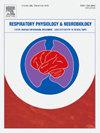非nmda谷氨酸受体在新生大鼠呼吸控制和高氧诱导的可塑性中的作用
IF 1.6
4区 医学
Q3 PHYSIOLOGY
引用次数: 0
摘要
新生大鼠具有双相低氧通气反应(HVR),通常在出生后第二周成熟,但在中度高氧(30-60 % O2)条件下饲养的大鼠在3日龄的HVR后期已经表现出持续的通气增加(P3)。通过NMDA受体增强的谷氨酸能神经传递有助于HVR的正常成熟和高氧诱导的发育可塑性,但非NMDA谷氨酸受体的作用尚不清楚。为了研究非nmda谷氨酸受体在呼吸控制和高氧诱导的可塑性中的作用,将新生大鼠暴露于21 % O2(对照组)或60 % O2(高氧)中,直到P3-4时通过头-体体积描图测量HVR。全身给药AMPA/kainate受体拮抗剂NBQX(12.5 mg kg−1,i.p)使两个治疗组的大鼠采用更慢、更深的呼吸模式,并适度降低基线分钟通气和对流需求。NBQX也降低了两组缺氧后1分钟的HVR,但没有改变HVR的整体形状;高氧大鼠无论是否接受生理盐水或NBQX注射,在暴露于11 % O2的整个15分钟内,通气持续增加,而对照组大鼠则有强烈的双相HVR。因此,通过非nmda谷氨酸受体的谷氨酸能神经传递在新生大鼠的呼吸控制中起重要作用,而在慢性产后高氧后表达的呼吸可塑性中不起作用。本文章由计算机程序翻译,如有差异,请以英文原文为准。
Role of non-NMDA glutamate receptors in respiratory control and hyperoxia-induced plasticity in neonatal rats
Newborn rats have a biphasic hypoxic ventilatory response (HVR) that typically matures during the second postnatal week, but rats reared in moderate hyperoxia (30–60 % O2) already exhibit a sustained increase in ventilation during the late-phase of the HVR by 3 days of age (P3). Enhanced glutamatergic neurotransmission through NMDA receptors contributes to both normal maturation of the HVR and hyperoxia-induced developmental plasticity, but the role of non-NMDA glutamate receptors is unclear. To investigate the involvement of non-NMDA glutamate receptors in respiratory control and hyperoxia-induced plasticity, newborn Sprague Dawley rats were exposed to 21 % O2 (Control) or 60 % O2 (Hyperoxia) until their HVR was measured by head-body plethysmography at P3–4. Systemic administration of the AMPA/kainate receptor antagonist NBQX (12.5 mg kg−1, i.p.) caused rats from both treatment groups to adopt a slower, deeper breathing pattern with a modest reduction in baseline minute ventilation and convection requirement. NBQX also attenuated the HVR measured during the first minute of hypoxia in both treatment groups, but it did not alter the overall shape of the HVR; Hyperoxia rats exhibited a sustained increase in ventilation throughout the entire 15-min exposure to 11 % O2 regardless of whether they received saline or NBQX injections, while Control rats had a strongly biphasic HVR. Therefore, glutamatergic neurotransmission via non-NMDA glutamate receptors plays an important role in the respiratory control of neonatal rats but not in the respiratory plasticity expressed after chronic postnatal hyperoxia.
求助全文
通过发布文献求助,成功后即可免费获取论文全文。
去求助
来源期刊
CiteScore
4.80
自引率
8.70%
发文量
104
审稿时长
54 days
期刊介绍:
Respiratory Physiology & Neurobiology (RESPNB) publishes original articles and invited reviews concerning physiology and pathophysiology of respiration in its broadest sense.
Although a special focus is on topics in neurobiology, high quality papers in respiratory molecular and cellular biology are also welcome, as are high-quality papers in traditional areas, such as:
-Mechanics of breathing-
Gas exchange and acid-base balance-
Respiration at rest and exercise-
Respiration in unusual conditions, like high or low pressure or changes of temperature, low ambient oxygen-
Embryonic and adult respiration-
Comparative respiratory physiology.
Papers on clinical aspects, original methods, as well as theoretical papers are also considered as long as they foster the understanding of respiratory physiology and pathophysiology.

 求助内容:
求助内容: 应助结果提醒方式:
应助结果提醒方式:


